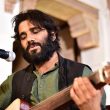India’s classical and folk music traditions have always been defined by reinvention. Yet many of the instruments that shaped the country’s sonic identity have quietly disappeared from contemporary practice. As global music culture increasingly celebrates heritage sound, India is entering a moment of rediscovery.
As part of SOI’s Soundscapes Reimagined initiative, the Lost and Rare Instrument Exhibition at DARSHANAM 2 brings forgotten instruments back into the conversation. The showcase highlights their history, the craft that shaped them, and the unique timbre they offered generations of musicians. The platform is presented in collaboration with Serendipity Arts Festival and includes demonstrations by singer, songwriter and innovator Kavish Seth, who will present his Noori – Vadyagram project, including live luthiery sessions and instrument mapping.
A cultural revival aligned with national vision
For the Indian Performing Rights Society (IPRS), this effort is part of a larger cultural responsibility.
Rakesh Nigam, CEO of IPRS, frames the initiative as both preservation and evolution.
“India’s musical heritage has never been static it is a living, breathing story of creativity and innovation. With the Exhibition of Rare and Lost Instruments of India at Soundscapes of India Season 2, our intent is to bring that story closer to today’s audiences and reconnect them with the roots of our sonic identity. These instruments have shaped India’s musical journey for generations, yet many now lie silent and forgotten. It is time their sounds are heard again.”
He adds that this cultural revival aligns with national priorities.
“Aligned with the Government of India’s vision to preserve, document, revive, and promote the country’s intangible cultural heritage, the exhibition at Soundscapes of India echoes the ongoing efforts of the Ministry of Culture and its autonomous bodies to safeguard traditional instruments from disappearing and reintroduce them into the modern musical landscape.”
For Nigam, the idea is not just legacy, but future-building.
“By showcasing these instruments to both Indian and international audiences, we are not just preserving history we are reigniting a dialogue between the past and the present… ensuring they continue to inspire new compositions, collaborations, and a renewed sense of pride in our collective musical legacy.”
Reconnecting audiences with sound and story
The exhibition brings instruments from diverse regions, the Northeast, Rajasthan, Karnataka, Bengal and beyond. It aims to invite new audiences into a cultural archive that is deeply contemporary in its potential.
Rumpa Banerjee, Head of Corporate Communications and Member Relations at IPRS, explains:
“Soundscapes of India Season 2 celebrates the depth and diversity of India’s musical heritage a heritage that continues to inspire, and resonate with audiences from across the globe.”
She describes the exhibition as a bridge between generations and creative cultures.
“Many of these instruments, once the voice of communities and traditions, are rarely heard today. To experience them up close is to rediscover the living rhythm of India itself one that continues to evolve while honouring its roots.”
At a time when India’s youth are increasingly curious about authentic sonic identity, this platform aims to ignite participation rather than passive viewing.
“These instruments are more than artefacts; they are echoes of culture, emotion, and storytelling that transcend time. Showcasing them in a space that unites artists, curators, and cultural delegates from around the world reaffirms India’s role as a vital contributor to the global soundscape a nation where tradition and modernity coexist in perfect harmony.”
Heritage as a contemporary language
The exhibition also brings together cultural institutions, traditional instrument makers and contemporary musicians. This collaboration is key to ensuring relevance beyond nostalgia.
Helen Acharya, Former Secretary at Sangeet Natak Akademi, emphasises continuity through creative practice.
“Our musical heritage is among the oldest and most diverse in the world, yet many of its instruments have faded from collective memory. Exhibitions like this at DARSHANAM 2 are crucial to reviving these cultural treasures.”
For her, the event creates space for live cultural transmission.
“By bringing together traditional instrument makers, musicians, and contemporary creators under one roof, it transforms heritage into living dialogue… ensuring that the sounds of India do not just remain in archives and museums, but thrive and find resonance in our contemporary music and on global stages.”
The artist’s perspective: innovation through tradition
For artists like Kavish Seth, the project is artistic exploration as much as conservation.
“I am delighted to be a part of an initiative at Soundscapes of India that celebrates the very soul of Indian music, its instruments, makers, and stories.”
His Noori ki Or – Vadyagram project showcases how traditional craftsmanship evolves through cultural interplay.
“We aim to revive the dialogue between sound and craftsmanship by showcasing instruments, their origins, and show how innovations take place as a result of cultural exchange between the diverse soundscapes.”
And for Seth, this is ultimately about creative future-building.
“India’s musical heritage is vast and deeply layered, and it is time we make these sounds heard, many of which are on the verge of being forgotten part of our contemporary music language again.”
A living archive for the future of sound
The Lost and Rare Instrument Exhibition arrives at a moment when global and Indian music are expanding beyond genre boundaries. As electronic producers sample folk recordings and indie songwriters return to acoustic textures, the possibilities for India’s traditional timbres are widening.
This initiative positions forgotten instruments as living tools for composition, collaboration and identity. If contemporary artists embrace them, the next wave of Indian sound could draw just as much from ancient forests and desert winds as digital labs and global playlists.
India’s future sound, it turns out, might begin by listening back.








